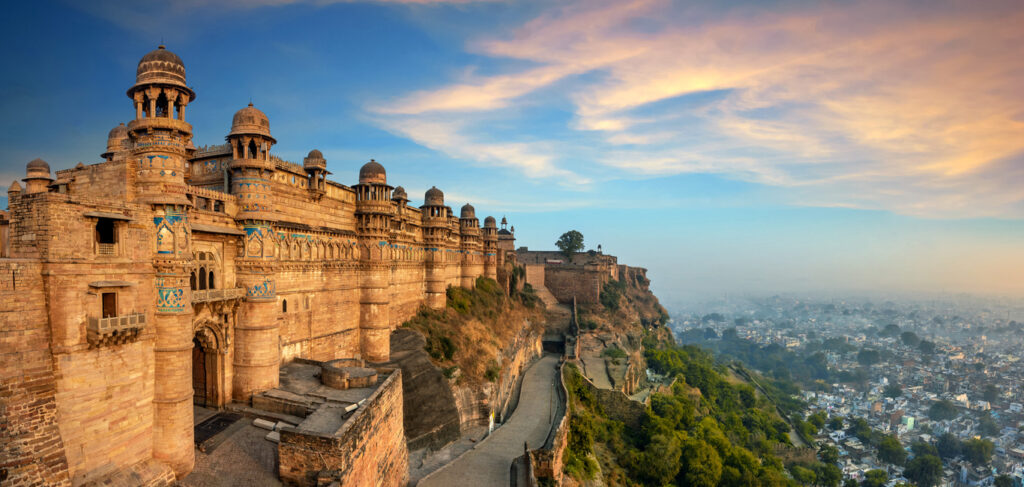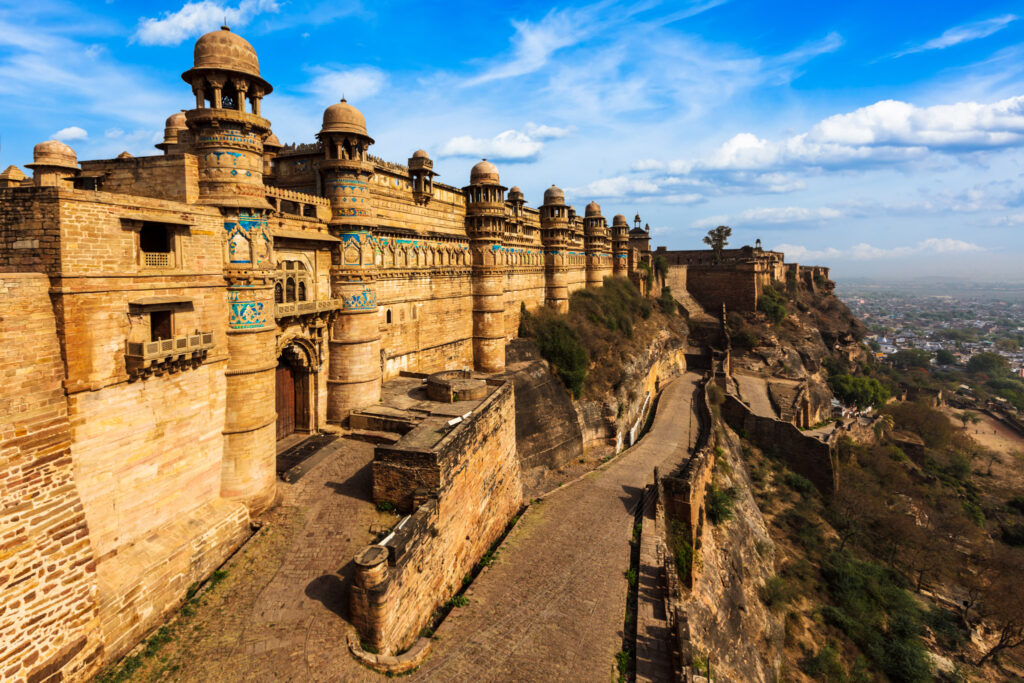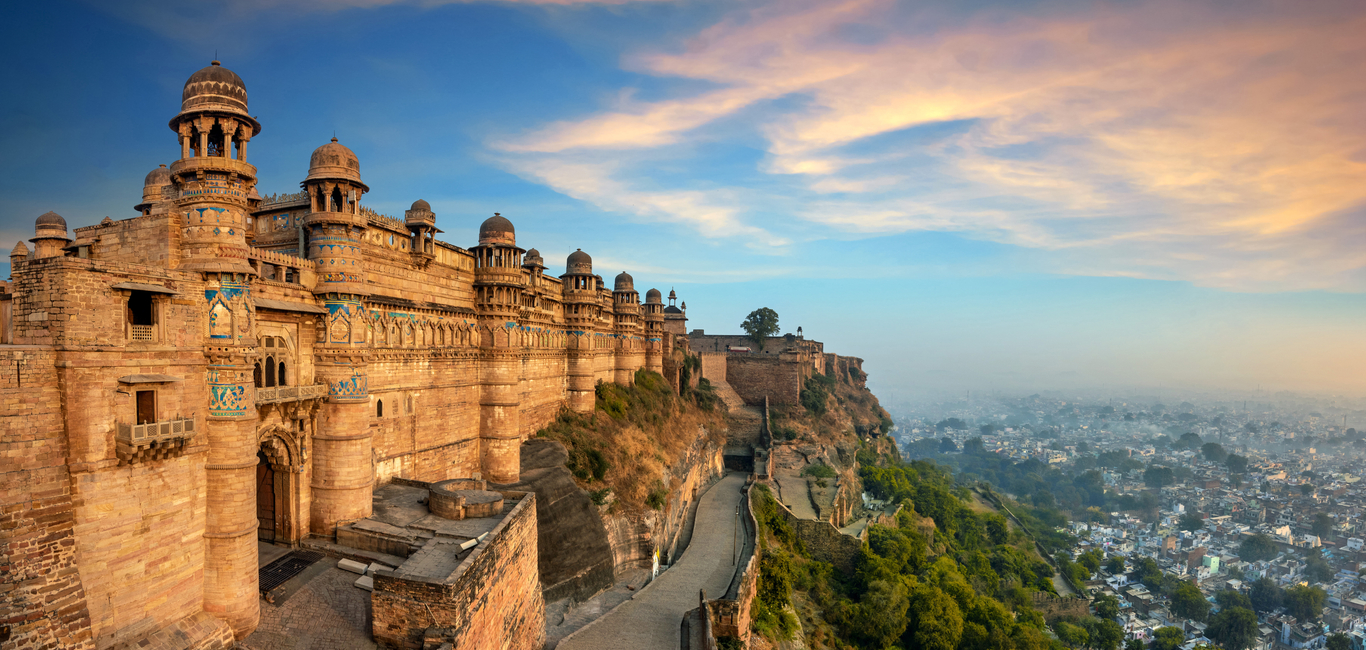Referred to as ‘the pearl amongst fortresses in India’ by Mughal emperor Babur, the Gwalior Fort is one of the most impenetrable fortresses in northern and southern India and is a place you definitely must visit. Situated on the top of a vast rocky mountain near Gwalior in Madhya Pradesh in central India, this imposing structure dominates the entire city of Gwalior. An inseparable part of the identity and architecture of the town, evidence suggests that it has been around since the 6th Century. It is also where the second oldest reference of the number ‘zero’ has been found in the form of a carving inside a temple on the top of the fort.
The construction of the Gwalior Fort took place in two parts, in two different periods; thus, this architectural marvel has an intriguing history. It has passed from the possession of one dynasty to the other multiple times. The fort complex is well maintained and includes temples, water tanks, and palaces such as Man Mandir, the Gujari, the Jahangir, the Karan, and the Shah Jahan.

History of Gwalior Fort
The period during which the Gwalior Fort was constructed is unknown. According to legends, this imposing fort was built in the 3rd Century by a local king Suraj Sen. The king had recently been cured of leprosy with the help and blessings of a sage named Gwalipa, who had offered him water from a sacred pond. The grateful king then built this fort and named it after the sage. The word Gwalior is derived from the saint’s name- Gwalipa. The sage bestowed the title Pal, which means protector, upon the king; and declared that the fort would remain in his family’s possession as long as they bore this title. Interestingly enough, the fort remained with the 83 descendants of Suraj Sen Pal, but the 84th descendant named Tej Karan lost the fort.
In the years that followed, the Gwalior Fort has witnessed many ups and downs. It also changed hands many times and was held by the Tomars, Mughals, Marathas, and the British, before finally being handed over to the Scindias.
The architecture of Gwalior Fort
Surrounded by concrete walls of sandstone, the Gwalior Fort encloses three temples, six palaces, and several water tanks and is truly an architectural marvel. The different palaces and temples reflect the architectural finery and skill that existed during those times and continue to be appreciated.
The most beautiful place on the entire premises is undoubtedly the Man Mandir Palace, which with its amazingly elaborate structure, seems to hang at the edge of the impressive fort. Blue ceramic tiles form the facade of this breathtakingly beautiful palace. The Teli-ka-Mandir, built in the 9th-century Dravidian style, rises to a height of over 100 feet and is famous for its blend of South Indian architecture with North Indian decorative motifs, as well as an exquisitely sculpted exterior. The Saas-Bahu temples on the eastern side of the fort are also larger-than-life examples of 11th-century temple architecture.
Gwalior Fort Light & Sound Show
The Gwalior Fort hosts a spectacular sound and light show every evening. This show is exceptionally well executed and makes you feel like you are part of the fort’s rich history and the love story of Raja Man Singh and his queen Mrignayani.
The show takes place in the amphitheater at the Man Mandir. The timings for the show are as follows:
Hindi Show: 7:30 pm
English Show: 8:30 pm
Best Time To Visit Gwalior fort
The best time to visit the Gwalior Fort is during the autumn and spring, that is, between October and March. One can also enjoy the visit during the monsoon when the surrounding is verdant green and fresh and crisp air.
Reputed to be among the most beautiful fortresses in the country, the Gwalior Fort is a thriving tourist destination today. Exuding energy that speaks of the days gone in a harmonious tune, the walls of this fort capture your attention as soon as you step into the complex of Gwalior ka Kila. Much to the pride of the locals, this fort has become a place of worship, wonder, and sheer amazement for travelers from all over the world. Situated around four kilometers from the city center, the fort of Gwalior should be part of your travel itinerary.
While some folks get swept away in the Khajuraho-Ujjain temple-hopping trip, the ones who genuinely love discovering ancient monuments must visit this fortress. The timings of the Gwalior Fort are 9 am to 5 pm every day of the week. The tickets for adults are Rs. 75, Rs. 40 for children and Rs. 250 for foreigners, respectively. The ideal time to visit this magnificent fort would be between October and March, as the temperatures are relatively pleasant.

Let us acquaint you with Gwalior Kila with these 7 interesting facts: –
1. The Ambiguous Origin of the Fort
When we discuss the origins of Gwalior ka Kila, it is essential to note that the main structure has been standing tall since the 6th Century! That’s right. As old as monuments can be, this fort has witnessed every season, war, and love story known in the Indian subcontinent. Legend has it that the Gwalior Fort was built by Suraj Sen, a Sakarwar Rajput, in honor of the saint who saved his life. According to folklore, Gwalipa was a sage who offered the king water from a sacred pond (still found within the Gwalior ka Kila complex) when he suffered from leprosy. Upon consuming this water, the king was cured instantly of the disease and thanked the sage for his kindness. In return, Gwalipa blessed him and his coming generations to rule the land without any hindrances. Experts and historians who provide heritage walk at this fort often tell this fascinating story. History buffs on Gwalior tour packages should participate in one of the walks to learn about the inception of this fort.
2. Monuments and Temples within the Premises
A fort with several temples and monuments inside its premises clarifies how different cultures, traditions, and kingdoms left their mark on it. In its entirety, there are 11 temples belonging to the Jain Tirthankaras, with the tallest idol of Rishabhanatha or Adinatha hoisted up to a height of 58 feet! Besides this, Gwalior Kila’s Teli ka Mandir or Tellika Temple is a famous tourist destination. It was built in the 9th Century by the Gurjara-Pratihara dynasty. Right next to this temple is the Garuda monument in honor of Lord Vishnu. This monument’s most unique characteristic is that it influences Hindu and Islamic architecture.
Even today, the palaces inside the Gwalior Fort have a separate set of admirers. The most popular one was Man Mandir Palace, built by Maharaja Man Singh in the 15th Century. Karn or Karan Mahal, built by his successor, Kirti Singh, is another palace worth visiting. Last but not least is Vikram Mahal, a palace constructed under the rule of Vikramaditya Singh, the eldest son of the first Tomar king.
3. Invasion by Foreign Powers
In 1505, Sikander Lodi attempted to invade the Gwalior Fort. However, the attempt was unsuccessful. This is because the Tomars were renowned for their valor and left no stone unturned to protect their fortress. After the demise of Man Singh, the battle ended with Gwalior Kila in the hands of the Delhi Sultanate. But with the rising presence of the Mughals in North India, this fort was snatched away within a decade. A power struggle began in 1542 between the Delhi Sultanate and the Mughals, with Gwalior Kila as the winning prize. Sher Shah Suri took the entire fortress in a fierce battle. Upon your visit here today, you will understand why this fort was significant to these powers. Not only is it strategically located on a hilltop, but it also brings out the grandeur of an empire ruling in it. Keeping this in mind, you will also learn that Akbar was the first Mughal emperor to turn this glorious fort into a prison. Information on the Gwalior Fort’s captures by various kingdoms can also be found at the Archaeological Museum within the premises.
4. Prison for the Sixth Sikh Guru
As mentioned earlier, the most benevolent Mughal emperor, Akbar, first used the Gwalior Fort as a prison for political entities that infiltrated his empire. Following his father’s footsteps, Jahangir made sure that this fortress was utilized in oppressing the sixth guru of Sikhism, Guru Hargobind. To shed some light on the youngest religion in India, spreading harmony under the rule of the Mughals, you should know that Guru Arjan was executed by Jahangir because of their increasing influence on the people. Guru Hargobind, a born warrior, dedicated his life against the Mughal rule and was imprisoned at Gwalior Kila for 14 years. Mind you, he was only 11 years old at that time. The reason given by the Mughal authorities was that the Sikhs could not pay the fines imposed on them. Although there is no known record of the time of his release, it is estimated to be around 1611. The fort of Gwalior became a sight of oppression for the Sikhs, but the positive outcome was the introduction of Bandi Chhor Divas at Gurdwara Data Bandi Chhor situated inside the complex. This festival is still celebrated in honor of Guru Hargobind’s release from the Mughals. Because of this historical event, this fort is part of the Gwalior sightseeing one-day tour for people from the Sikh community.
5. Home to the Second Oldest “Zero.”
Did you know that Gwalior Fort has the ‘second oldest zero recorded history? On your way to Hathi Pol or Elephant Gate, you will come across Chaturbuj temple dedicated to Lord Vishnu. This particular temple is one of the places to visit in Gwalior to read the inscription depicting zero in a mathematical equation. This plaque dates back to 875 CE, second to the oldest note with zero in the world! To elaborate on the written details, the inscription mentions a land grant of 270 hastas (measuring unit in ancient times) made for a flower garden.
Along with this, it mentions a daily grant for 50 flower garlands as well. The numbers “270” and “50” both have zero mentioned in them. The timing in the Gwalior Fort best suited for observing the “zero” is right when the gates open, as it is less crowded.
6. A Temple Construction Out of a Domestic Feud
As far as domestic feuds are concerned in India, we all know that nothing good comes from it. Except for this particular historical fact. Sahastrabahu Temple, commonly known as Sas-Bahu Temple, located inside the Gwalior Fort, is perhaps the only positive outcome of an altercation between a mother-in-law and a daughter-in-law. During the reign of the Kachchhapaghatas, it is believed that a feud broke out between the mother-in-law and her daughter-in-law regarding the deity to be worshipped inside this temple. To resolve this issue, both Lord Shiva’s and Lord Vishnu’s gods were accommodated inside this twin temple to please both the ladies of the royal family. Imagine if domestic matters could be resolved so peacefully in today’s times!
7. The Legend of Tansen’s Tamarind Tree
Tansen, the legendary musician of the Mughal courts, has a melodious connection with Gwalior Kila. A tamarind tree inside the fort is believed to have leaves that can make your voice harmonious! This folklore has been around for ages mainly because of Tansen’s tomb inside the fort and his magical voice reverberating into nearby villages. The sound and light show organized nowadays illustrates this legend along with the love story of Man Singh and Mrignayani in the most peaceful manner. The timings of this show differ according to the season, so you can plan your trip to this fort accordingly.
It is with good reason that Gwalior Fort stakes its claim as one of the top hill forts of India. Visit it and experience it in its full glory!
Visit MakeMyTrip for bookings. Also, have a look at our various monthly issues.

